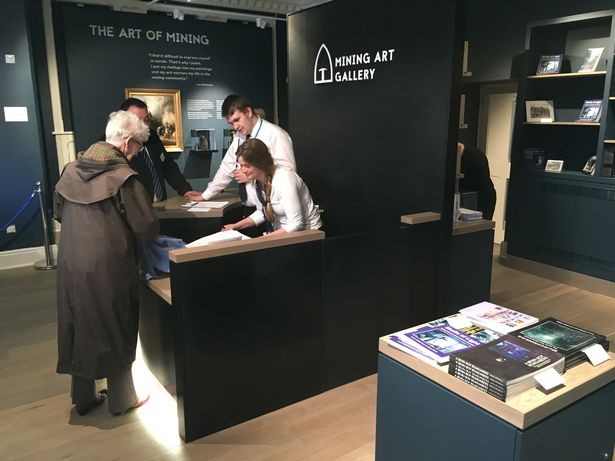
 






.gif)



|
Signature Sponsor


November 11, 2017 - It looks a bit like a castle and it used to be a bank but the eye-catching building in England's Bishop Auckland Market Place is now a significant visitor attraction.
It opened as the Mining Art Gallery a couple of weeks ago and people have been flocking.
Most regular gallery-goers will be used to a solitary experience. Away from the blockbuster exhibitions in London, there’s rarely a rush or a crush.
Put the right things on display, though, and people will come. The Mining Art Gallery is a revelation. I hadn’t seen so many visitors in a gallery since the Leonardo da Vinci drawings came to the Laing in Newcastle early last year.
Visitors at the Mining Art Gallery, Bishop Auckland Photo by ncjMedia
The 10 tiny drawings were looked at reverentially and also with a sense of urgency. On show for a brief period, they would soon return to the protective shadows.
The same reverence was evident when I visited the Mining Art Gallery which shows the work of pitman artists.
On show are paintings of a world fast fading. It’s the world of coal with its dangers, its camaraderie, its close-knit communities and its colourful culture expressed at annual events like the Durham Miners’ Gala.
You enter the gallery at ground level but the dark walls give a sense of subterranean gloom. As you ascend to the upper levels, the colour scheme lightens as if you are nearing the daylight that in the depths of winter many miners seldom saw.
Norman Cornish, Berrimans Chip Van. Gemini Collection, Zurbarán Trust Photo by Colin Davison
In a warren of seven galleries, mostly small and intimate, are paintings and drawings hung as if they were Old Masters, with loving care.
And everywhere were people studying them intently, sometimes seemingly lost in a private world of memories and sometimes sharing reminiscences with a friend or friends.
As with the collection of the Ashington Group at Woodhorn Museum, this is art that appeals to people who profess not to know about art. They respond to the subject matter.
But that doesn’t mean this isn’t good art. Tom McGuinness, Norman Cornish and Bob Olley all worked underground but are best known for their distinctive paintings – and, in Bob’s case, sculptures – which are held in high regard.
Artwork on display at the Mining Art Gallery, Bishop Auckland Photo by ncjMedia
At the Mining Art Gallery you will see their paintings and work by others like them.
Not all are from the North East. Vincent Evans, born in South Wales in 1896, went underground at the age of 13 but later won a scholarship to the Royal College of Art. His painting, After the Blast, is on loan from National Museum Wales.
Samson Gilbert Daykin, born near Barnsley in 1886, also became a miner at 13 but started to paint after his marriage in 1910.
His talent drew him to the attention of his local MP and also the Duchess of Portland who invited him to London to visit its galleries.
The Daily Mirror carried a photo of him on its front page (August 3, 1931) wearing his flat cap.
The Mining Art Gallery, Bishop Auckland Market Place Photo by ncjMedia
His 1938 painting, The Miner Enslaved, on loan from the Science Museum Group, is a powerful exhibit here. Not merely descriptive, it has religious connotations.
Miners, you’ll learn over and over again in this place, made many sacrifices. Their work was hard but there were creative souls among them who sought solace at places like the Spennymoor Settlement and with the Ashington Group in their hut.
Despite his evident talent, Daykin could never afford to leave the mines.
Always fearful of a mining accident, he died on December 20, 1939, caught with five colleagues in a 5,000-ton rock fall – just one hour before the end of his last pre-Christmas shift.
The Hartley Pit disaster of 1862, when five miners died instantly and 199 were entombed alive, is immortalised in paintings by HH Emmerson (born in Chester-le-Street in 1831) and Yorkshireman John Henry Leonard (1834-1904).
Ted Holloway, Testing for Gas. Gemini Collection, Zurbarán Trust Photo by Colin Davison
The latter’s watercolour, showing the burial of victims in Earsdon churchyard, has the arresting immediacy of a modern news photo.
The Mining Art Gallery, not far from Auckland Castle, is another example of Jonathan Ruffer’s philanthropy.
Much of this now falls within the remit of The Auckland Project (formerly the Bishop Auckland Trust).
Genevieve Adkins, its curatorial programme director, described The Mining Art Gallery as “a piece of serendipity”.
The Auckland Project’s main focus in the town centre had been on the Faith Museum – under development at Auckland Castle – and the forthcoming Spanish Gallery which will soon see masterpieces from that country’s so-called Golden Age displayed in the Market Place.
The Last Drop by Robert Olley, Mining Art Gallery Photo by ncjMedia
But then Mr Ruffer, the wealthy financier who has made Bishop Auckland’s regeneration his mission, met Robert (Bob) McManners and Gillian Wales who have built up a body of mining art called the Gemini Collection.
Lacking a permanent home for the swelling collection, much of it has been stored until recently in Robert’s attic.
“They saw a real opportunity to create a mining art gallery in Bishop Auckland which would be the first in the country,” said Genevieve.
“The reason that was important to The Auckland Project was that the Prince Bishops, who owned Auckland Castle, also owned the mineral rights to County Durham.
A detail from Durham Miners' Gala by Tom McGuinness showing the added figures of Gillian Wales and Robert McManners Photo by ncjMedia
“The history of the Prince Bishops is intimately connected to the region’s mining heritage. It’s part of the story we wanted to tell.
“So we had Bob and Gillian who wanted to put their art on public display and Jonathan who loves art and wanted to make that happen.”
The disused bank was purchased, along with two adjoining cottages, and the whole was tastefully refashioned into the gallery with its little linked rooms and themes such as A Dangerous Life, Beneath the Surface and Heroines of the Coalfield (beautiful portraits here by Norman Cornish).
It may all be down to serendipity, a purely chance development, but it has proved hugely popular.
The Mining Art Gallery, Bishop Auckland Photo by ncjMedia
On the opening Saturday people queued all day to get in with at least 1,000 passing through before the weekend was out.
“That shows you just how important this is to the local people,” said Genevieve.
“It has also been very important to us. We have the Faith Museum and the Spanish Gallery coming but we felt this was the part of the project that local people would feel most emotional attachment to.
“We felt this was the way to engage them with art.”
About one third of the works currently on display are from the Gemini Collection whose founders, naturally, are delighted.
Norman Cornish, Crowded Bar. Gemini Collection, Zurbarán Trust Photo by Colin Davison
For Bob and Gillian, building their collection over decades has been a labour of love from which we can all now benefit.
Bob said they first met Mr Ruffer at the Bowes Museum, Barnard Castle, where they had an exhibition called Shafts of Light.
He revealed that they had already had their eye on the old bank when they discovered The Auckland Project had snapped it up.
“I think it makes a great gallery with its nooks and crannies,” said Bob.
He and Gillian are both from Bishop Auckland and separately fell for the work of Tom McGuinness, the wartime Bevin Boy who joined the sketching club at the Spennymoor Setllement and subsequently studied at Darlington School of Art.
Gillian Wales and Robert McManners with Durham Miners' Gala by Tom McGuinness, 1968 Photo by ncjMedia
Bob, a retired GP, was given a McGuinness etching when he was accepted to go to medical school in Newcastle.
Gillian, working as a librarian in the 1970s, met the artist when he asked to put up a poster. In 1993, when Bishop Auckland Town Hall was renovated, Gillian became manager and a McGuinness exhibition was an early attraction.
It was in 1996 that the pair discovered their shared passion. They produced a book about the artist soon afterwards and then began to collect work by mining artists, often from the artists themselves.
Remembering some of their encounters with the pitmen artists, they laugh.
“They didn’t value the paintings in a monetary sense but they wanted people to see them,” explained Gillian.
“When we went to see Jack Harrison, the last surviving member of the Ashington Group, he opened his airing cupboard and insisted we take a painting.”
The first painting they bought – on show in the gallery – is a huge and riotously colourful canvas called Durham Miners’ Gala, dating from 1968.
Delighted to have made a sale, Tom painted the pair of them – as youngsters – into the picture they had so admired. They then had to transport it home in an Austin Metro, resting on the back seat with Gillian lying underneath it.
The Gemini Collection is still growing. “I was given another picture yesterday,” said Bob.
“We haven’t purchased everything in the Gemini Collection. We’ve purchased a lot of it but artists have donated stuff because they wanted to be represented. They trusted us to look after it.”
Mining art finally has its own impressive North East showcase. Alongside those Spanish masterpieces, I reckon it won’t have to doff its cap.
The Mining Art Gallery, in Market Place, Bishop Auckland, is open every day from 10am to 4pm (last entry 3.30pm). For further information, please visit: www.aucklandproject.org. |
 











|

.jpg)
.jpg)
.jpg)
.jpg)
.jpg)
.jpg)
.jpg)
.jpg)
.jpg)